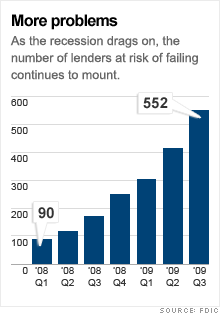Bank 'problem' list climbs to 552
Number at risk of failing soars in latest quarter. Deposit insurance fund slips into the red for first time since 1992.
NEW YORK (CNNMoney.com) -- Despite the frenetic pace of bank failures this year, 552 lenders are still at risk of going under, according to a government report published Tuesday.
The Federal Deposit Insurance Corp. said that the number of banks on its so-called problem list climbed to its highest level since the end of 1993. At that time, the agency red-flagged 575 banks.
Mounting bank failures have proven costly for the FDIC, the government agency created to cover the deposits of consumers and businesses in the event that a bank is shut down.
On Tuesday, the agency revealed its deposit insurance fund, as a result, slipped into the red for the first time since 1991.
At the end of the quarter on Sept. 30, the value of the fund was $8.2 billion in the hole. But that number accounts for $21.7 billion the agency has set aside in anticipation of future bank failures.
FDIC Chairman Sheila Bair, who has won praise both in Washington and on Main Street for shepherding the industry through a particularly difficult period, said the industry's fate is tied to the broader recovery.
"I think that it really is all about the economy at this point," said Bair.
The banks that end up on the problem list are considered the most likely to fail because of difficulties with their finances, operations or management.
Still, history has shown just 13% of banks on the list have failed on average.
Regulators however, never make public the names of the banks on the list out of fear the publicity could cause customers to pull out their deposits.
Tuesday's report did reveal that the number of assets controlled by those institutions climbed to $345.9 billion from $299.8 billion in the previous quarter.
The ongoing recession has already claimed 124 banks so far this year. But fears persist that the number will multiply in months ahead because banks are still taking losses on mortgage-related loans and face growing problems with commercial real estate.
In the event of a failure, the FDIC fully insures individual accounts up to $250,000 for single accounts.
In anticipation of future bank failures, the FDIC has been scrambling to shore up its ailing deposit insurance fund.
Earlier this year, the agency imposed a special assessment on all banks. And just recently, it approved having banks prepay their insurance premiums for the next three years.
The move is expected to generate roughly $45 billion for the FDIC. However, due to accounting rules, the fund would not be back in the black until 2012.
One lingering question is whether, at some point, the agency would need to tap its $500 billion credit line with the Treasury Department, which was approved earlier this year.
The agency however, has been averse to the idea, hoping instead it can instead navigate the crisis using the tools already at its disposal.
Tuesday's report however, wasn't all bad news.
The roughly 8,100 institutions that make up the nation's banking industry earned $2.8 billion during the third quarter. In the previous quarter, banks were in the red, losing a combined $4.3 billion.
Stronger sales and the rising values of some securities certainly helped, but those gains were capped as lenders again set aside massive amount of cash to cope with future loan losses. All told, banks earmarked $62.5 billion for future loan losses.
While that was down slightly from the previous quarter, Bair cautioned not to read too much into the numbers, adding that number could jump back up in the current quarter.
"I think we need to live with this a bit longer," she said. "I wouldn't read too much in quarter-to-quarter trends."
One persistent trend, however, was that credit continued to remain tight. In fact, loan balances at the nation's lenders fell 2.8% of $210.4 billion, representing the largest quarterly decline since banks started reporting this figure in 1984.
Some economists have argued that the lack of available credit to borrowers, such as small business owners, is choking off the economic recovery. Banks, on the other hand, have argued that demand for loans is way off, as both consumers and businesses try to pay down debt. ![]()



